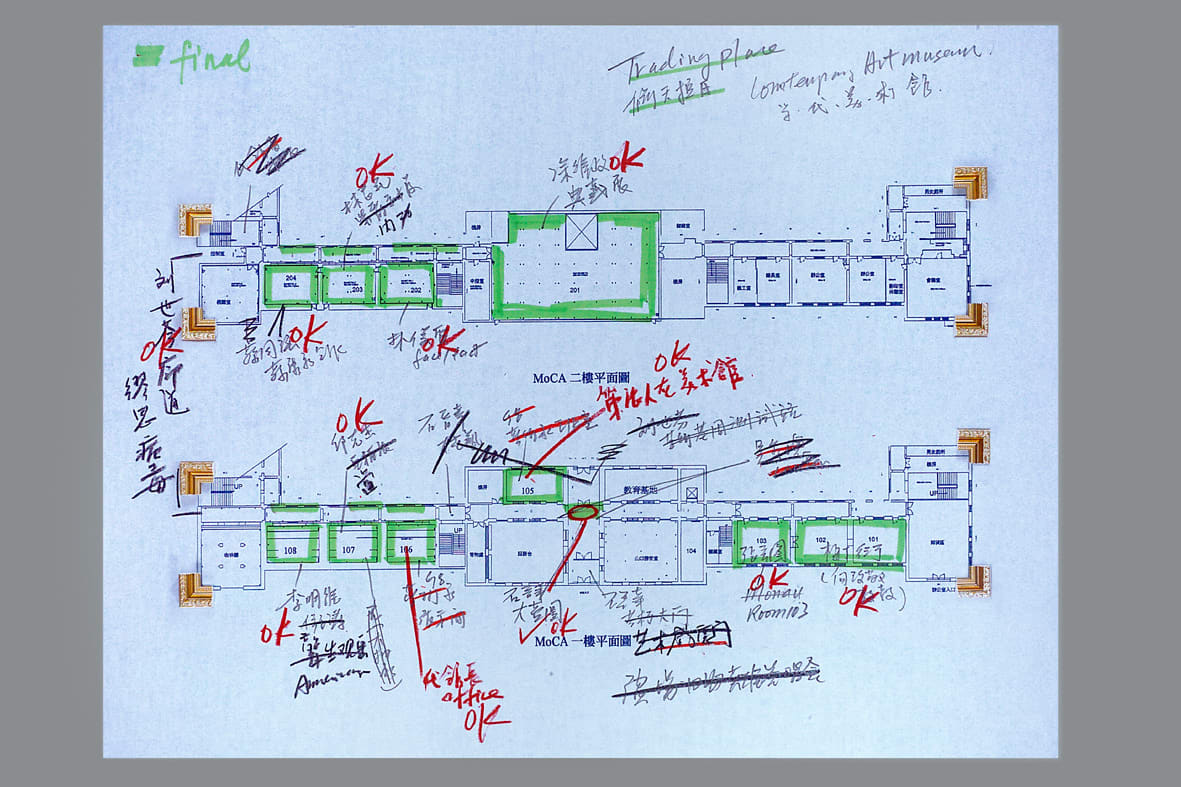 “The Grand Blue Print of ART”
《藝術大藍圖》
“The Grand Blue Print of ART”
《藝術大藍圖》 Installation view, 300 x 400 cm
展場照
Installation view, 300 x 400 cm
展場照
Shi Jin-Hua
61 × 80 cm (Collector's Edition Small Size),
29.7 x 21 cm (Document).
Further images
I was invited to participate in a joint exhibition curated by the Museum of Contemporary Art, Taipei. I asked the museum for the blueprint of its building. Subsequently, I scanned and doctored the floor plan of the first and second floor onto one sheet of paper. At the same time, I asked the curator to jot down notes about the exhibition on the blueprint. The curator ’s notes included artists participating in the exhibition, their ideas about the exhibition, and the title and location of each piece of artwork. I scanned the blueprint afterwards, which included the curator’s handwritten notes. The blueprint was then enlarged, printed, and put on display on the floor of the exhibition venue. I framed the image of the Taipei Contemporary Museum of Art floor plan with eight carved, golden frames. This attempt was to highlight how the larger context dominates and influences art as we see it. During the exhibition, visitors are free to walk over the large blueprint.
I used the frame as a symbol to represent art as well as those who appreciate art. In this piece of artwork, I thought about the following questions: “In a themed exhibition, what exactly is art? Is it the artworks per se? Is it the act of curating an exhibition? Or is it the museum as a venue?” I also thought, “If the curator has already determined what art is, and the larger context has already determined the meaning and value of art; then, what is this game of art, politics and power, with multiple parties involved, really about?” “What determines the definition of art? What determines its meaning and value?” In the real world of art, I do not have an overarching answer that deals with the dominance of the curator and the exhibition space. All I am left to do is to highlight the power and dominance of the larger context or institutions on contemporary art. However, there is only so much I can do, since the idea behind my project needs to be approved by the curator and the organizing institution.
我在2005年春天獲邀參加一個在台北 當代藝術館的聯展,我從館方取得該館的建築藍圖資料,掃瞄、合成輸出一張一、二樓的平面圖。我請策展人將策展過程中的所有變動紀錄在當代館的平面藍圖上。這些變動包括:參與藝術家的陣容、藝術家參展的構想、作品名稱、作品位置等。爾後我將這張有策展人策劃手跡的藍圖掃瞄、放大輸出,鋪放裝置在展場地板上,並以8個金色雕花的畫框邊角,框住藍圖中的台北當代藝術館,藉以突顯當代藝術中的閱讀脈絡與知識權力的宰制性。展覽期間觀眾可以走在這張大藍圖上。
我把畫框當作一個符號使用,用來象徵藝術的範疇、審美的對象。在這件作品中我反思與提點的問題是:「在一個有主題的策劃性展覽中,什麼才是藝術自身?是作品?是策展?還是美術館這塊場域?」「如果說展覽的框架決定了藝術是什麼,觀看的脈絡決定了意義與價值,那麼這一場多方參與的藝術政治與權力遊戲,究竟是怎麼一回事?」「什麼決定了藝術是什麼?什麼決定了意義與價值?」在藝術的現實世界裡,我沒有解決策展的質性與藝術機構空間的宰制性的方案,只能突顯當代藝術中的閱讀脈絡與權力關係,因為這件作品的構想還是要經過策展人與機構的同意。
Exhibitions
2005 “Trading Place: Contemporary Art Museum”, Museum of Contemporary Art, Taipei, Taiwan2005「偷天換日:當.代.美.術.館」,台北當代藝術館,台北,台灣
Publications
2013 “Shi Jin-Hua”, Mind Set Art Center, Taiwan2005 “Trading Place: Contemporary Art Museum”, Taipei Culture Foundation, Taiwan
2013 《石晉華》,安卓藝術股份有限公司,台灣2005《偷天換日:當.代.美.術.館》,財團法人台北市文化基金會,台灣



